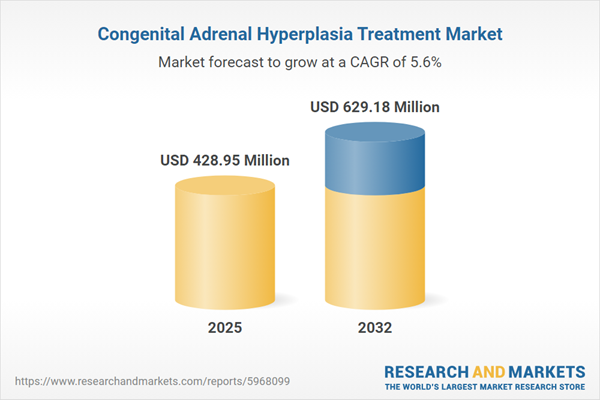Speak directly to the analyst to clarify any post sales queries you may have.
The congenital adrenal hyperplasia treatment market is rapidly changing as new pharmaceutical therapies, advanced diagnostics, and digital health solutions shape clinical practice. Senior executives require a focused overview of this sector’s current trajectory and evolving business landscape.
Market Snapshot: Congenital Adrenal Hyperplasia Treatment Market Overview
The congenital adrenal hyperplasia treatment market is valued at USD 405.57 million in 2024 and projected to reach USD 428.95 million by 2025, translating to a 5.64% CAGR. Sustained growth in this area is fostered by the steady expansion of drug development pipelines, integration of advanced diagnostic technologies, and ongoing transitions toward individualized medical approaches. Advances in early detection support more precise therapy choices from the start of care. Digital health platforms allow for immediate clinical adjustments and foster collaborative, data-driven decisions between healthcare providers and their patients. As regulations and market conditions shift across different regions, companies encounter specific challenges, risks, and new prospects requiring tailored strategies.
Scope & Segmentation
- Drug Type: Androgen inhibitors, glucocorticoids (including dexamethasone, hydrocortisone, and prednisone), and mineralocorticoids are the primary drug classes, supporting individualized regimens aligned with patient genetics and physiological needs.
- Route of Administration: Intravenous, oral, and topical delivery address both urgent and ongoing care needs, increasing patient comfort and adherence while enabling therapeutic flexibility.
- Formulation: Capsule, injection, suspension, and tablet forms—offered in immediate-release and extended-release variants—enable clinicians to align treatment to clinical requirements and patient lifestyles.
- End User: Medical care is delivered through hospitals, specialty clinics, and home care providers, enhancing accessibility and supporting both traditional and innovative healthcare pathways.
- Age Group: Solutions are tailored for neonates, children, and adults, integrating safety and efficacy to support comprehensive, age-specific care across the patient spectrum.
- Distribution Channel: Hospital pharmacies, retail outlets, and online channels collectively maintain treatment access and facilitate logistical resilience, especially in regions facing geographic or infrastructure challenges.
- Geographic Coverage: Analysis covers North America, Latin America, EMEA, and Asia-Pacific. Each region presents unique regulatory, reimbursement, and distribution environments that necessitate nuanced strategy to address local market requirements.
- Companies Analyzed: Leading participants include Pfizer Inc., Novartis AG, Teva Pharmaceutical Industries Ltd., Viatris Inc., Sanofi S.A., AstraZeneca plc, Baxter International Inc., Dr. Reddy’s Laboratories Ltd., Aspen Pharmacare Holdings Limited, and Gedeon Richter Plc—benefitting from global clinical networks and alliances.
Key Takeaways: Strategic Guidance for Decision-Makers
- Pharmaceutical advancements and digital monitoring are driving more tailored clinical intervention, resulting in timely and patient-specific treatment delivery.
- Collaboration between pharmaceutical firms, technology developers, and clinical specialists is streamlining drug pipeline progression and regulatory engagement.
- Interdisciplinary care models that encompass genetics, endocrinology, and pharmacy teams are improving chronic management and enhancing patient compliance.
- Adaptive strategies enable companies to navigate diverse payer structures and regulatory frameworks across regions, strengthening readiness for evolving policy environments.
- Proactive supply chain planning, structured around scenario analysis, is crucial to mitigate risks from economic volatility and ensure ongoing therapy availability.
- Efforts to embed pharmacogenomic data into clinical decisions are refining the precision of care for complex endocrine conditions.
Tariff Impact: Navigating US Drug Import Tariffs
Drug import tariffs in the United States are prompting many companies to reassess production costs, invest in domestic manufacturing facilities, and seek greater vertical integration. These developments reinforce supply reliability and enhance payer negotiation leverage. The adoption of biosimilars and flexible contracting approaches is also helping stabilize costs and maintain continuous patient access during evolving reimbursement cycles.
Methodology & Data Sources
This analysis draws from a combination of secondary research, expert consultations, and targeted insights from market panel respondents. Strategic evaluations include scenario modeling and SWOT analysis, providing nuanced, actionable perspectives for leaders in the congenital adrenal hyperplasia treatment field.
Why This Report Matters
- Enables senior leadership to identify and prioritize opportunities, facilitating nimble responses to advancements in medical technology and regulatory developments.
- Supports resource allocation and business planning tailored to evolving payer demands and overall market forces, enhancing organizational alignment.
- Prepares stakeholders to sustain resilience and adapt strategically to the shifting regulatory and commercial landscape of congenital adrenal hyperplasia treatment.
Conclusion
This market analysis delivers a focused foundation for refining business strategy, enhancing resilience, and advancing organizational value within congenital adrenal hyperplasia treatment.
Additional Product Information:
- Purchase of this report includes 1 year online access with quarterly updates.
- This report can be updated on request. Please contact our Customer Experience team using the Ask a Question widget on our website.
Table of Contents
3. Executive Summary
4. Market Overview
7. Cumulative Impact of Artificial Intelligence 2025
Companies Mentioned
The companies profiled in this Congenital Adrenal Hyperplasia Treatment market report include:- Pfizer Inc.
- Novartis AG
- Teva Pharmaceutical Industries Ltd.
- Viatris Inc.
- Sanofi S.A.
- AstraZeneca plc
- Baxter International Inc.
- Dr. Reddy’s Laboratories Ltd.
- Aspen Pharmacare Holdings Limited
- Gedeon Richter Plc
Table Information
| Report Attribute | Details |
|---|---|
| No. of Pages | 185 |
| Published | October 2025 |
| Forecast Period | 2025 - 2032 |
| Estimated Market Value ( USD | $ 428.95 Million |
| Forecasted Market Value ( USD | $ 629.18 Million |
| Compound Annual Growth Rate | 5.6% |
| Regions Covered | Global |
| No. of Companies Mentioned | 11 |









